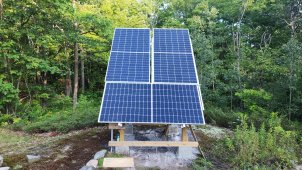Mof
New Member
- Joined
- Jul 7, 2021
- Messages
- 46
I have a Midnite Classic 150, currently being fed by 2 panels with the following specs:
Pmax: 579W
Vmp: 40.9V
Imp: 14.16A
Voc: 48.9V
Isc: 15A
All good.
I would like to add a third panel, but will run into Voc issues when it is cold.
Attached is a PDF of the sizing tool output from Midnite Solar. It indicates the Classic150 will go into HyperVOC at <=17 Celsius. I will experience plenty of days warmer than this, and many more significantly colder than this.
Other than switching to a Classic 200(too expensive), my idea is to install a DPDT switch in the string so i can manually disconnect one of the 3 panels when the temperature puts the Classic 150 into HyperVOC.
Anyone tried this? Any pitfalls, advice, or wisdom?
Assuming this idea is workable, another question:
Lets say I have 2 panels connected on a cold morning. Later in the day the panels warm up in the sun to a point where the output of 3 panels would no longer exceed the 150V charge controller limit. Any issues just flipping the switch and reconnecting the 3rd panel? IE will the sudden jump in voltage harm the Classic150 controller?
Pmax: 579W
Vmp: 40.9V
Imp: 14.16A
Voc: 48.9V
Isc: 15A
All good.
I would like to add a third panel, but will run into Voc issues when it is cold.
Attached is a PDF of the sizing tool output from Midnite Solar. It indicates the Classic150 will go into HyperVOC at <=17 Celsius. I will experience plenty of days warmer than this, and many more significantly colder than this.
Other than switching to a Classic 200(too expensive), my idea is to install a DPDT switch in the string so i can manually disconnect one of the 3 panels when the temperature puts the Classic 150 into HyperVOC.
Anyone tried this? Any pitfalls, advice, or wisdom?
Assuming this idea is workable, another question:
Lets say I have 2 panels connected on a cold morning. Later in the day the panels warm up in the sun to a point where the output of 3 panels would no longer exceed the 150V charge controller limit. Any issues just flipping the switch and reconnecting the 3rd panel? IE will the sudden jump in voltage harm the Classic150 controller?
Attachments
Last edited:




